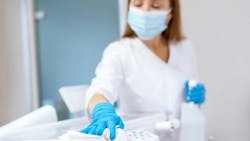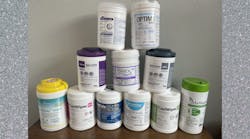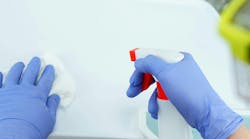Are natural disinfectants a good choice for your operatory?
I’m not alone in my concern about all the chemicals we use in dentistry. Are they bad for our equipment, or even our health, since we touch them and breathe in the fumes? Is there a more natural disinfectant we can use that is still compliant?
These are all great questions. Many of the disinfectants we use come with a “signal” word, such as caution or warning, indicating the negative effects they can have on health. Of course, we want them to kill all the bioburden left behind after each patient, but at the same time, we want them to be safe for us and our equipment.
In March 2024, the Nature Neuroscience Journal published a research paper discussing how some of the chemicals we use to disinfect can impair neurodevelopment into adulthood.1 All too often, we treat our disinfectants like baby wipes or spray them in the air without thinking about what we’re inhaling.
But before you ditch your current product in favor of something more natural, there are things to consider to ensure you properly disinfect your operatory.
What is the efficacy?
The EPA regulates the disinfectants used in dentistry. Any disinfectant you choose must have an EPA number, and the number needs to appear on two important lists. List B lets you know if your disinfectant is effective against tuberculosis (TB), and list S shows that the disinfectant is effective against bloodborne pathogens. Those are the benchmark pathogens to look for to determine if a disinfectant is acceptable.
When you look up your disinfectant on the EPA list, you might find it has a different name. Many companies use a formula that was tested under a different name, or the product has been “white labeled,” meaning it’s the same product as another brand but with a different label.
What is the kill time?
Operatory turnover needs to be done efficiently. My next patient is often already waiting when I walk the current one to the front desk. Pay close attention to the TB kill time on the label or the EPA website. This is the time the disinfectant needs to remain wet after the cleaning step in order to be effective against TB, which is the harder pathogen to kill. As I’ve investigated some of the natural disinfectants, many of the TB kill times are 10 minutes or more. This is likely too long for most dental practices.
How long is the shelf life?
Another point to consider when choosing a disinfectant is how long the product can be stored. Most traditional disinfectants can sit on the shelf for two years. Some natural disinfectants aren’t shelf-stable for long, or they must be mixed or generated daily or weekly.
Be sure to follow the instructions for use so you know your disinfectant is actually disinfecting. It’s no fun when a product expires on the shelf or in the spray bottle. Consider this before you order a case of something, and if you’re mixing, be sure to label it with the date so no one accidentally uses a product that doesn’t work.
What is the surface compatibility?
Many people are drawn to natural disinfectants in the hopes they will be less likely to damage the surfaces they’re disinfecting. While that might be true, it’s still important to do your homework. Traditional disinfectants clean and disinfect, first removing the bioburden and then killing pathogens. Check to ensure your product can do both or you might need an additional compatible cleaner. Just because it’s natural doesn’t mean it won’t interact with your surfaces or other products.
Before switching products, give your equipment a soap-and-water bath. This will remove any residue left behind from the previous disinfectant. Sometimes, residue from noncompatible products can interact and discolor or damage surfaces.
Wear your personal protective equipment (PPE)
No matter how safe or natural your surface disinfectant is, it’s important to remember that when you turn over a room, bloodborne pathogens are still present. Wear the proper PPE to protect yourself. This includes eye protection, a mask, and gloves. Heavy-duty gloves are necessary when handling any sharps or if the product requires it. If the product says you don’t need PPE, it’s referring to the product, not the disinfection process. Standard precautions still apply.
Do your homework
There’s a lot to consider when choosing a disinfectant. While it’s easy to rely on your product reps or companies, it’s important to do a little homework to ensure the product you’re using meets all the criteria for keeping you and your patients safe.
Editor's note: This article appeared in the Aug/Sept 2024 print edition of RDH magazine. Dental hygienists in North America are eligible for a complimentary print subscription. Sign up here.
Reference
1. Cohn EF, Clayton BLL, Madhavan M, et al. Pervasive environmental chemicals impair oligodendrocyte development. Nat Neurosci. 2024;27:836-845. doi:10.1038/s41593-024-01599-2
About the Author

Amanda Hill, BSDH, RDH, CDIPC
Amanda Hill, BSDH, RDH, CDIPC, is an enthusiastic speaker, innovative consultant, and award-winning author who brings more than 25 years of clinical dental hygiene and education to dentistry. Recipient of ADS’s Emerging Infection Control Leader award and an active participant with the advisory board for RDH magazine, DentistryIQ, and ADS’s Infection Control in Practice Editorial Review Board and membership committee, Amanda (also known as the Waterline Warrior) strives to make topics in dentistry accurate, accessible, and fun. She can be reached at [email protected].


